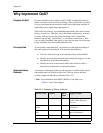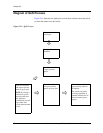
25-2 User Guide for the Avaya P580 and P882 Multiservice Switches, v6.1
Chapter 25
Why implement QoS?
Purpose of QoS In a network that has time-sensitive traffic (VoIP) or bandwidth-intensive
traffic (real-time or near-real-time streaming-video), QoS makes it possible
for you to prioritize the time-sensitive traffic and assign larger amounts of
bandwidth to those applications that require it.
VoIP traffic has relatively low bandwidth requirements, but cannot tolerate
latency or frame loss. Therefore, this traffic needs a high priority to ensure
its timely delivery. On the other hand, streaming video is bandwidth-
intensive but has large “jitter buffers” so can tolerate some latency. Thus,
you can assign streaming video traffic a lower priority than voice, but must
assign streaming video more bandwidth than voice.
Prerequisites To successfully implement QoS, you must have a thorough knowledge of
the traffic patterns in the network. You need this information to:
■ Classify traffic and assign it the required priority and bandwidth.
■ Identify the areas of the network where bottlenecks might occur and
that therefore need bandwidth limiting.
■ Identify the areas of the network where time-sensitive traffic is
being delayed and needs to be prioritized better.
Implementation
Example
An example of managing QoS across the network is to define traffic classes
and manage these on a network-wide basis. The four classes and their
priorities might look like those outlined in Table 25-1.
* Note: For information about DSCP (DiffServ Code Point), see
“Diffserv” later in this chapter.
Table 25-1. Examples of Classes of Service
Service Class Priority DSCP
Value
Type of Traffic
Highest Priority 7 56 Network Management
Traffic, OSPF, Spanning
Tree, etc.
Time Sensitive
Traffic
5 40 Real-time voice, video
conferences.
High Priority
Data
1 8 SAP, Web, etc. Dependent
upon your business.
Best Effort 0 0 Everything else.


















